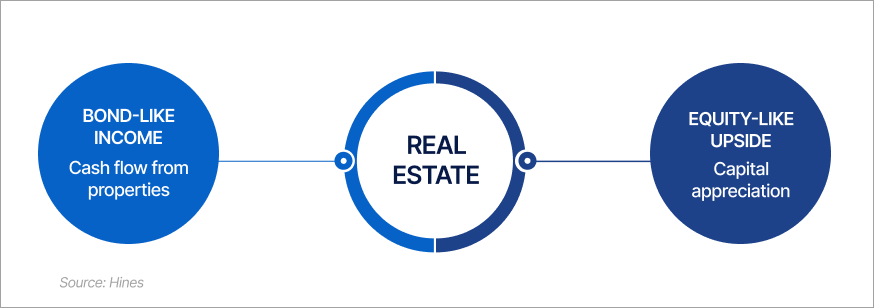Investors today face a mix of challenges: sticky inflation, shifting global growth, and heightened volatility in public markets. On top of this, private real estate has seen its returns come under pressure in recent years with rising interest rates and tighter lending conditions that have hit valuations and slowed capital flows.
Many investors have questioned whether the asset class still delivers. In today’s environment however, private real estate stands out again not just as a diversifier, but as an asset class with a distinctive blend of income, resilience, and growth potential. Let’s take a look at key reasons why this asset class is finding renewed relevance.
The hybrid advantage
Private real estate has a unique hybrid quality, combining bond-like characteristics with equity-like growth potential.
- Bond-like income: Leases and tenant contracts generate recurring cash flow
- Equity-like upside: Property values can rise, driving capital appreciation
According to Hines Research, private real estate is a “natural bridge between the two traditional buckets of stocks and bonds for private wealth portfolios, as they move forward from the traditional 60/40 compositions to embrace the inclusion of a higher percentage of investments in alternatives.”1

These features position real estate uniquely among alternatives - it can generate current income while still capturing upside from long-term appreciation.
Protecting purchasing power with real estate income
In an environment with persistent inflation, one of the biggest investor concerns is erosion of purchasing power. Here, real estate shows its strength:
- Rental income tracks inflation: Lease structures often allow for rent increases tied to consumer price indices or market resets.
- Essential nature of assets: Housing, logistics, and even offices in the right locations meet enduring economic needs, providing durable demand.
- Predictable distributions: Long-term contracts provide cash flows less sensitive to daily market swings.
With both income and valuations tied to real economic activity rather than public market sentiment, private real estate has historically shown greater resilience through periods of volatility. This resilience is further reinforced by real estate’s ability to diversify both by geography and by strategy.
Diversification within the diversifier
Investors often speak of diversification across equities, bonds, and alternatives, but diversification can also happen within real estate itself.
- By geography: More than two-thirds of global investible commercial property lies outside the US. Hines Research highlights that global private real estate has shown the capacity to reduce overall portfolio risk by investing across markets with economic cycles that are not closely correlated.1
- By strategy:
- Core/Core-plus: Stable income with moderate appreciation.
- Value-added: Income and appreciation, amplified by value creation.
- Opportunistic (development): Appreciation driven.
- Private debt: Income driven.
This breadth makes private real estate not just a diversifier, but a multi-layered asset class where investors can choose risk and return profiles that fit their objectives. Such diversification does more than balance risk and return, it creates a platform to capture opportunities emerging from global macro shifts like AI, deglobalisation, and sustainability.
Macro shifts creating tailwinds
Several structural shifts are shaping the opportunity set in 2025 and beyond:
- AI and data-driven logistics: The rise of AI is accelerating demand for smarter, tech-enabled supply chains, boosting the need for advanced logistics hubs, warehouses, and data-driven industrial facilities.
- Deglobalisation: Supply chain realignment is driving demand for logistics and industrial space in new hubs.
- Sustainability: Regulations and tenant preferences are accelerating demand for energy-efficient “green” buildings, creating opportunities for forward-looking assets.
- Demographics: Ageing populations support sectors like senior housing, while urbanisation continues to fuel demand for multifamily housing.
- Capital market constraints: Banks are retreating from some forms of lending, creating space for private real estate debt strategies to step in.
These themes highlight that real estate is not static. It evolves with global economic and social currents.
What this means for investors
Bringing these elements together, private real estate offers key qualities many investors seek today: income resilience with cash flows often linked to inflation, diversification in practice through exposure across regions and strategies, and potentially attractive entry points as capital costs reset lower and new opportunities emerge.
As highlighted by Hines Research, the asset class “can perform well even in a paradigm shift to higher equilibrium inflation, higher uncertainty, and lower regional economic correlation.” While private real estate carries risks such as illiquidity and sector-specific headwinds, it remains an allocation with renewed relevance.
At ADDX, we continue to expand access to high-quality investment opportunities. Real estate is one of the pillars of this effort, offering tangible, resilient, and globally diversified exposure and a clear reason why private real estate is back in focus for investors today.
References:
1Hines Research, “Why Real Estate: Finding Value Amid Uncertainty,” July 2025.
This article is for general informational purposes only and has not been independently verified to ensure its accuracy and fairness. This article does not constitute any advice or recommendation from ADDX or ICHX Tech Pte. Ltd. (“ICHX”) or any of its affiliates. Please consult your own professional advisors about the suitability of any investment product/securities/ instruments for your investment objectives, financial situation and particular needs. No representation, warranty or other assurances of any kind, expressed or implied, is made with respect to the accuracy, completeness, adequacy, reliability validity or availability of any information in this article. Under no circumstance shall ADDX or ICHX bear any liability to the reader for any loss or damage of any kind incurred as a result of the use or reliance on any information provided in this article. This article may not be modified, reproduced, copied, distributed, in whole or in part and no commercial use or benefit may be derived from this article without the prior written permission of ADDX and ICHX. ADDX and ICHX reserve all rights to this article.


